LS15 MIDTERM - UCLA Phelan
1/104
There's no tags or description
Looks like no tags are added yet.
Name | Mastery | Learn | Test | Matching | Spaced |
|---|
No study sessions yet.
105 Terms
1. Scientific thinking, what is it for? and be able to use it
scientific thinking
- empirical (based on observations and experiences not solely logic)
- self correcting
- observation
- hypotheses
- predictions
- experiments
- conclusions (modify hypotheses, and continue the process)
scientific method
- organized
- empirical
- methodical
- structured way of finding information about observable events in nature
- lets us reject hypotheses about how the world works
steps of the scientific method
1. make observations
2. formulate hypotheses - is it testable? refutable?
3. make a prediction
4. conduct an experiment - control all variables BUT one, randomized, double blind
5. analyze results, draw a conclusion (if evidence disproves hypothesis, construct a new hypothesis)
6. report results
is the scientific method flexible?
yes! it doesn't have to be step by step
what does a "critical experiment" do
put a hypothesis to the test, the results can decisively determine whether a hypothesis is correct
class examples of scientific method
- does it rain more on weekends?
- real vs artificial vanilla
- "maze bright" vs "maze dull" rats
class example: does it rain more on weekends?
- find average Monday and Saturday rainfall; rains 22% more on Saturdays
- hypothesis: particular matter from car exhaust builds up during the week leading to cloud formation and then rain on the weekends
- experiment: collect data from somewhere with no cars (ocean)
- results: there is equal rainfall on each day in the ocean, PROVING that car exhaust affects the trend of more rain on weekends
class example: real vs artificial vanilla in chocolate chip cookies
- Phelan baked batches of cookies with real vanilla and with artificial vanilla
- asked wife which one tasted better
- concluded that there was no difference in taste between the types of vanilla used
class example: is maze running genetic in mice?
- have "maze dull" and "maze bright" mice
- with each generation, test all mice for maze learning ability and breed only the top 20% and bottom 20%
- observe new generations
- conclusion: over time, the extremes got more and more exaggerated
- maze running is not genetic but the allele for fear is in mice; less fear = solve maze quicker, more fear = solve maze slower
how to increase experiment's power
- randomize subjects
- control your study
- use a double-blind design
R.C.D. - rat's cause diseases
what is the cost-benefit analysis of having a more controlled experiment?
it's a poorer model of the situation of interest
2. How does a hypothesis differ from a theory or prediction?
- a prediction only offers a guess of what will happen in the future
- a theory is a widely accepted idea that has serious evidence behind it, backing it up; ex: theory of evolution
- a hypothesis is a proposed explanation for observed phenomena
- a hypothesis must generate testable predictions
- theories are generally broader than hypotheses
null hypothesis
- a hypothesis that states a lack of relationship between 2 factors
- easy to disprove
ex: Echinacea has NO effect on the likelihood of catching the common cold or the duration of the symptoms of a cold
is it possible to prove a hypothesis is absolutely and permanently true?
no it's impossible
3. What does it mean to control an experiment?
- make sure there are no underlying differenced between the experimental groups
- change only ONE variable at a time
- treat all subject the same except for the one deviation which would not get the treatment and be the control group
treatments
an experimental condition applied to research subjects
experimental group
subject group exposed to the treatment
control group
subject group EXACTLY like the experimental group except they are NOT exposed to the treatment
variables
- characteristics of an experiment that are subject to change
- independent variable
- dependent variable
independent variable
whatever is manipulated in the experiment to be observed
dependent variable
what is measured as a result of the independent variable
blind experiment
when the experimental subjects do not know which treatment (if any) they are receiving
placebo
a group given the "fake" treatment
double-blind experiment
when neither the experimental subjects or experimenters know which treatment a subject is receiving
replication
repeating a study
4. Compare and contrast superstition, anecdotal observations, and pseudoscience
- pseudoscience: when individuals make scientific sounding claims that are NOT supported by trustworthy, methodical, scientific studies
ex: "9 out of 10 doctor recommend brand X"
How many doctors were there? How were they selected? What was the alternative to brand X?
- anecdotal observations: based on 1 or 2 (or a few) observations, people conclude there is or is not a link between 2 things
- superstition: belief in the supernatural to explain phenomena in the natural world; usually arises from a misunderstanding of science
5. If more and more observations support a hypothesis, do you predict it to be true? If not, Why?
- NO
- you don't prove it true, you just get to a point where you have so much confidence from different critical experiments conducted by different researchers that it's true
6. What is evolution? How can it occur?
- evolution: a change in allele frequencies within a population
- 4 ways it can occur: mutation, migration (gene flow), genetic drift, natural selection
mutation
direct alteration of DNA so that 1 allele is changed to another
migration/gene flow
within a population, some individuals leave or new individuals arrive, changing the overall allele frequencies
genetic drift
- a RANDOM change in allele frequencies
- Founder Effect
- bottleneck effect
ex: 2 Bb couples both have children with bb alleles
Founder effect
- small group leaves population and forms a new, isolated population
- this new population may have different allele frequencies than the original population so this new population will be dominated by the genetic features that happen to be present
ex: Amish population and polydactyly allele
bottleneck effect
- quick reduction of a population by a rapid environmental change (famine, disease) which reduces the population to a small fraction of its original size, changing the allele frequency of the population
ex: Cheetahs at the end of the last ice age nearly all died, so all the cheetahs living today can be traced to the dozen cheetahs that survived that bottlenecking event
difference between genetic drift and gene flow (migration)
- migration is WITHIN A SPECIES
- genetic drift is when a population moves to an entirely new area uninhabited by the species before
natural selection
non-random elimination of alleles
class example: evolution of starvation resistance
- fly can live without food for 20 hours
- what if you only let the "best" flies reproduce?
- let 5000 flies be born, take out food, wait for 80% to die, put food in, let top 20% reproduce, take out food...
- after 1 generation: 21 hours till death
- after 10 generations: 28 hours till death
- after 60 generations: 160 hours till death
gene
section of DNA carrying instructions for a trait
allele
- 1 variant of a gene (several may exist)
- we each carry 2 copies of every gene, 1 allele from our mom and 1 from our dad
7. What is natural selection and how does it work?
- natural selection is the non-random elimination of alleles
- 3 conditions that NEED to be satisfied: variation, heritability, differential reproductive success
3 conditions for natural selection and examples
- variation; eye color
- heritability; offspring resemble their parents
- differential reproductive success; turkeys with large breast reproduce more than turned with smaller breasts
types of natural selection
- directional selection
- stabilizing selection
- disruptive selection
- artificial selection
directional selection
- individuals with 1 extreme of the variation range have higher fitness
- mean changes, variation decreases
ex: farmers selectively breed cows with high milk production so subsequent generations will have less low milk producing cows
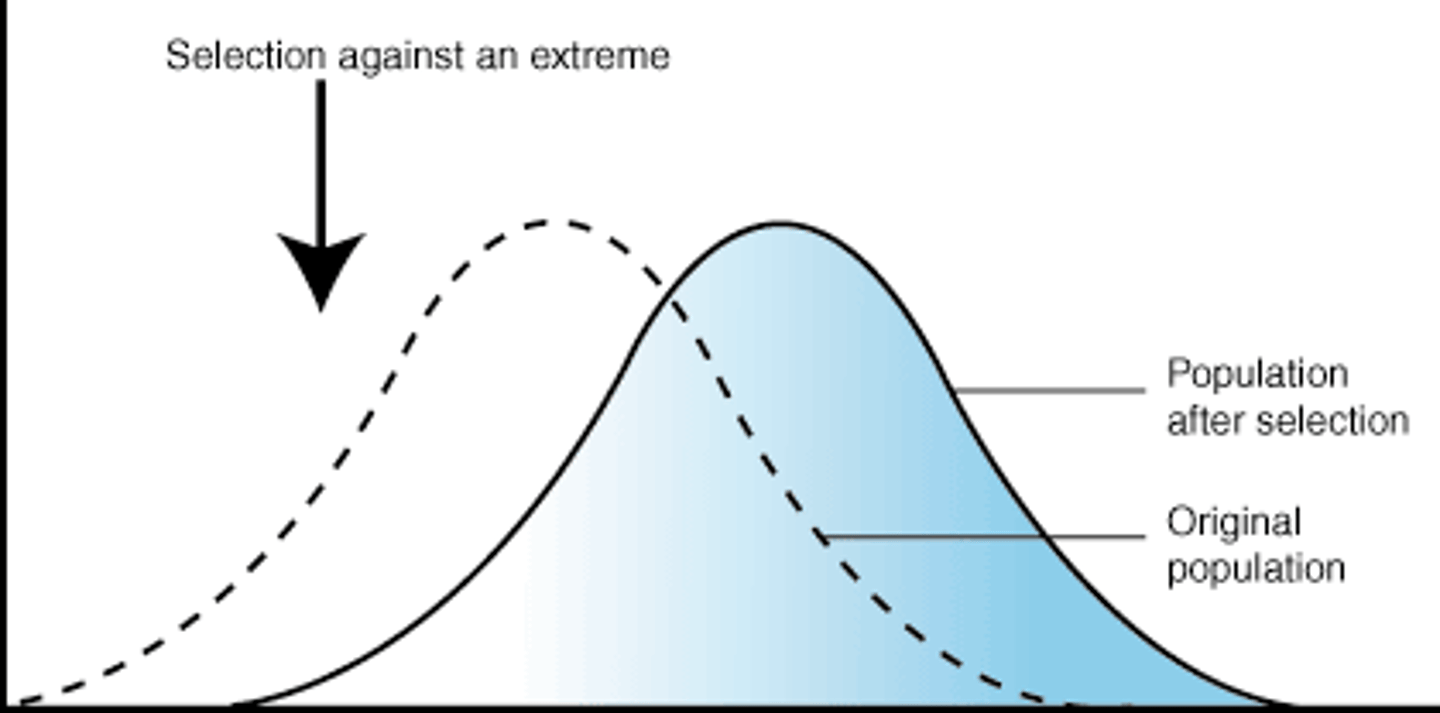
stabilizing selection
- when individuals with intermediate phenotypes have the highest fitness
- mean stays the same, variation decreases
ex: birth weight

disruptive selection
- individuals with extreme phenotypes have the highest fitness
- bimodal distribution, variation increases
ex: big fish can defend territory and small fish can sneak in and fertilize the eggs but the intermediate sized fish can't
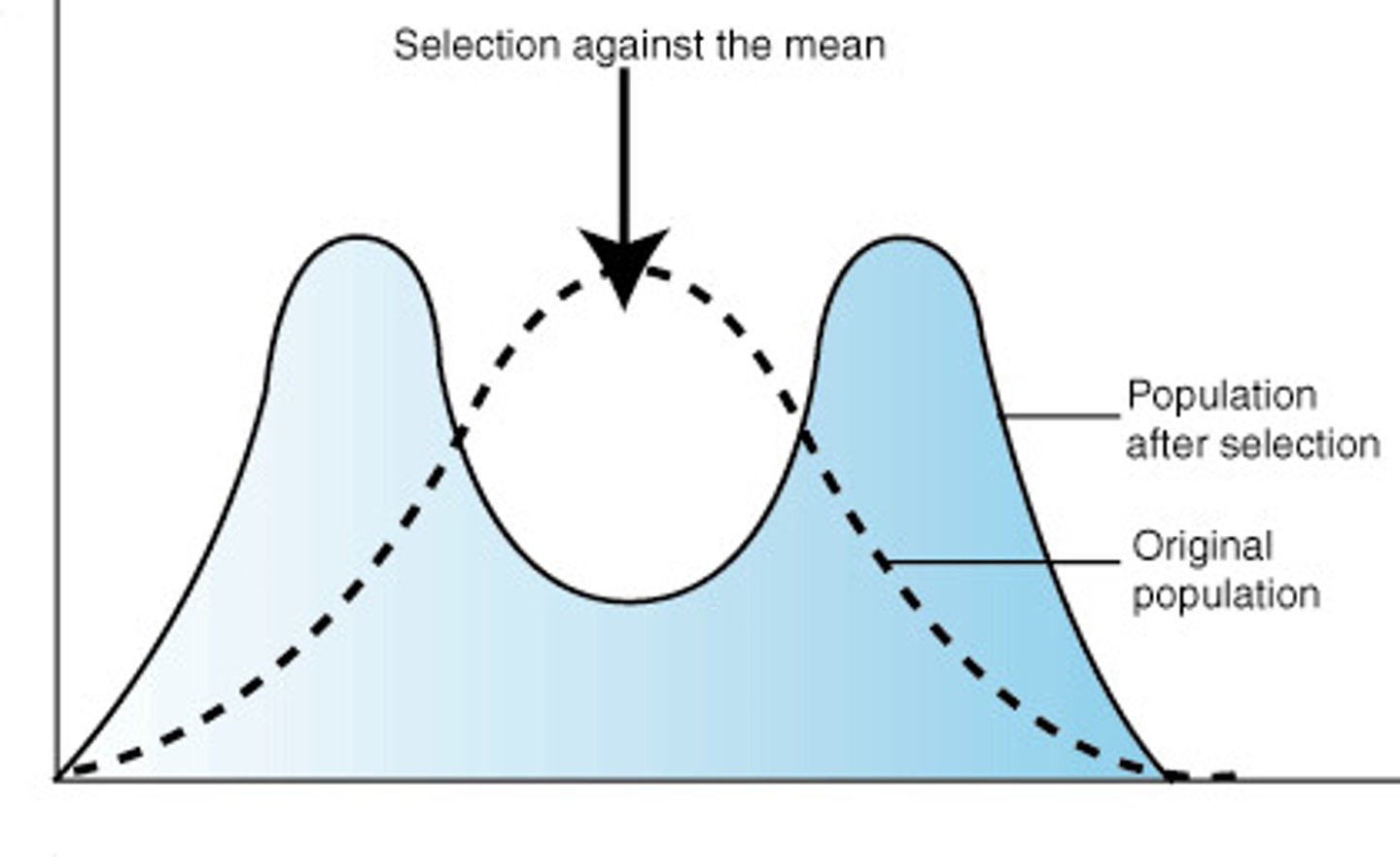
artificial selection
- goal oriented selection of favorable traits to produce offspring with more and more exaggerated versions of these traits
- differential reproductive success is determined by humans
ex: animal breeders breed dogs for specific traits for shows
8. What ideas and observations influenced Darwin?
On his trip on the Beagle around the world:
Finch variation:
- each island had unique species
- island species resembled mainland species
- maybe they used to be the same species?
Similarities between fossils of extinct species and the living species in an area:
- extinct glyptodonts looked like GIANT armadillos
Common themes in nature Darwin observed:
- offspring overproduction
- competition for scarce resources
- inheritance of traits; offspring look like parents
Concluded that there is a "struggle for existence"; organisms better suited to an environment have a greater probability of surviving and leaving more offspring
Through evolution, organisms become better matched with their environment
9. What is artificial selection and why does it almost always work?
- artificial selection: natural selection but humans choose the differential reproductive success
- satisfies natural selection's 3 conditions: variation, heritability and differential reproductive success
- if we choose the differential reproductive success, that implies that there's variation
ex: bred fruit flies to have super hair (bristle-y legs)
10. How is genetic drift related to Mendel's 1st law?
- genetic drift is a random change in allele frequencies
- mendel's law of segregation is that a gamete receives only 1 allele for each gene (are haploid)
- they are related because the gamete needs to be haploid so that when fertilization occurs, the species' diploid number is maintained. And when fertilization occurs, a random allele for each trait is passed on by each parents which could lead to a random change in allele frequencies
11. Sexual selection, what is it and why does it sometimes lead to tradeoffs?
- individuals of one sex acquire mates from the other sex
- causes: male to male competition or female choice
- "costly" traits: traits that increase an individual's status/appeal but is harmful to them
ex: bird's with big red bellies, long tailed birds
12. Reaction norms: how does the slope describe the relationship between genotypes and phenotypes?
- the set of all phenotypic expressions possible for a given genotype if raised under all possible different environmental conditions
- x axis: environment
- y axis: phenotype
- steep norm of reaction vs flat norm of reaction defines the influence of the environment on the phenotype
- nature vs nurture
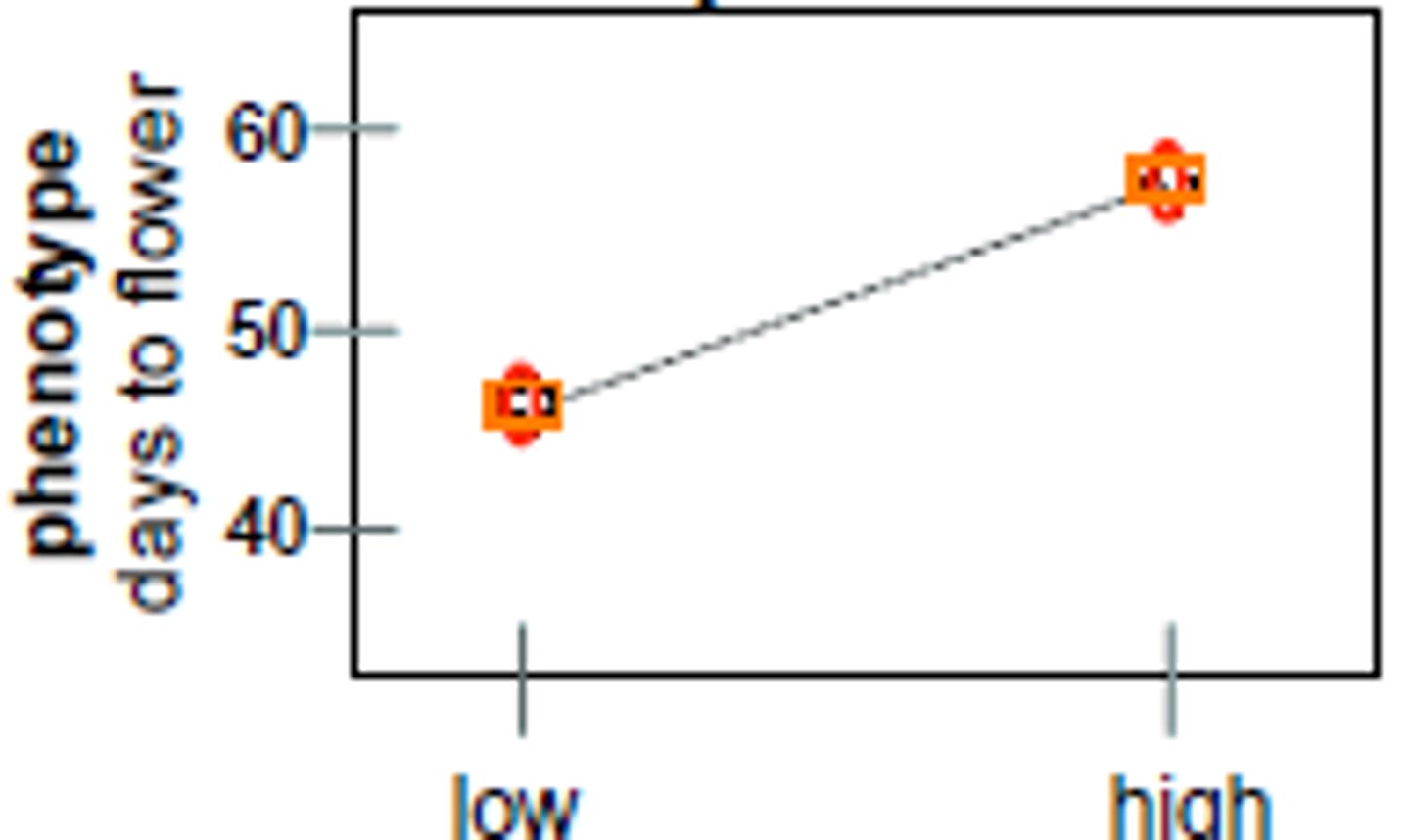
phenotype
observable qualities of an organism
genotype
internal state of hereditary factors
steep norm of reaction
B I G influence of environment on phenotype
flat norm of reaction
no matter what the environment is, the phenotype will stay the same
can be high up but still a flat norm of reaction
class example of reaction norms
- schooling environment on intelligence
- amount of food on phenotype
could you actually produce a norm of reaction?
no; because for a given genotype all the possible phenotypes would be an infinite number of iterations of that environment
13. What is evolutionary fitness? Why does evolution lead to selfish behaviors at the expense of those best for the species?
- evolutionary fitness is the relative success of an organism's reproductive success; how much market share their alleles have
- it leads to selfish behaviors because if everyone decides to produce less children to reduce the rate we use up all our resources, if one individual has an allele that makes them not care and produce 10 children, then in the next generation there will be 10 people who also has the allele of not caring and producing 10 more children of their own --> market share of people who do not care increase and market share of people who do decreases
- group selection
group selection
traits evolve so that the overall group fitness is higher or lower than the mean of the individual members' fitness values
nature vs nurture class example
- show someone a snake = sweaty, increased heart rate
- show someone a gun = no response in babies
- show someone from New Guinea a snake = no sweating bc knows snake is not poisonous
aka we are built with some underlying human nature that you CAN change
14. How do dominant and recessive alleles differ?
- a recessive allele only shows if the individuals has 2 copies of the recessive allele
ex: blue eyes is recessive, you need 2 copies of the allele to have blue eyes
- a dominant allele always shows, even if there is only 1 copy of it
ex: the allele for brown eyes is dominant; if you have 1 copy of the allele or 2 copies of it, you will have brown eyes
15. What was Mendel's 1st law and why do offspring look like their parents?
- Mendel's 1st law was segregation: a gamete receives only 1 allele for each gene
- offspring look like their parents because they inherit one allele from each for every trait which is reflected in their phenotypic resemblance which includes their biochemical characteristics, behavior, risks for disease, appearance...
16. Why don't full siblings look identical to each other?
- Mendel's 1st law of segregation is that a gamete receives only 1 allele for each gene
- mother and father each have 2 alleles for a trait but only pass on 1 to their offspring
- sibling don't look identical to each other because they could either have inherited the same alleles for a trait, or inherited none of the same alleles for a trait, or inherited one common allele for a trait
genome
all of an organism's genetic material
chromosome
linear strand of DNA
how many chromosomes do humans have
46 chromosomes in 23 pairs
karyotype
- picture of all the chromosomes in a cell numbered according to size
- usually get this while pregnant

homologous pair of chromosomes
1 paternal chromosome and 1 maternal chromosome paired together and at every physical location, they have the same gene

diploid (2N)
2 sets of chromosomes
ex: zygote
haploid (N)
1 set of chromosomes
ex: gamete
mitosis
replication of body cells to produce identical daughter cells
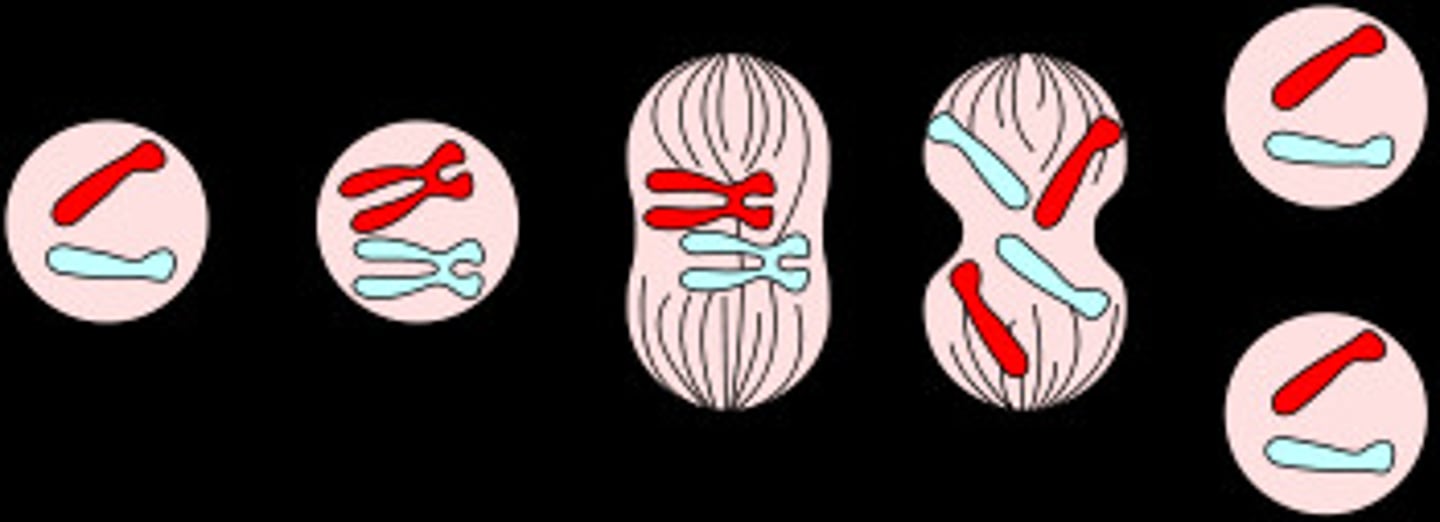
meiosis
- happens in gametes
- reduce the policy of cell by half (2N-->N)
- fertilization is when gametes recombine to form zygotes and restore the original number of chromosomes (2N)

Mendels 2 laws
- segregation
- independent assortment
Mendel's 1st law
- segregation
- a gamete receives only 1 allele for each gene
Mendel's 2nd law
- independent assortment
- alleles of 1 gene can segregate independently of alleles of other genes
ex: the allele for eye color doesn't have any effect on the allele for height
17. How is Mendel's 1st law of segregation relevant to gamete production?
- Mendel's 1st law of segregation is that each gamete receives only 1 allele for each gene
- segregation is when a diploid turns into a haploid, halving its number of sets of chromosomes from 2N to N
- necessary because when 2 gametes combine, they need to form the normal amount of chromosomes (2N) so that is why segregation is relevant and necessary
18. Mendel studied peas so to what extent does that limit his discoveries to the real world?
it doesn't because he described heredity not pea heredity
he just used pea plants so he could easily study his theory with easy to distinguish characteristics
Punnett squares
- female gametes on top
- male gametes on side
ex:
genotype ratios - 1GG: 2Gg: 1gg
phenotype ratios - 3 normal: 1 albino

19. How do you predict offspring genotype for sex-linked traits?
you use a punnett square as you would for autosomal traits BUT:
- use XX and XY
- superscript the "big b" and "little b"
how is the sex of a baby determined by the father?
- girl has 2 copies of the X chromosome but boys have a Y chromosome from the fathee
- girls: XX
- boys: XY
20. How does sex determination among different species vary?
- male heterogamety: gametes have x and y (humans)
- female heterogamety: in birds females are the one with ZW while males are ZZ
- ploidy: in insects, males are haploid and develop from unfertilized eggs while females are diploid
- incubation temperature: turtles have to keep eggs in a specific temperature which affects if they produce females or males
If an individual shows the dominant phenotype, how can you determine the genotype?
TEST CROSS
- cross the unknown individual with a homozygous recessive individual
1. if the unknowns offspring ends up having all the dominant phenotype, then the unknown is homozygous dominant
2. if the unknowns offspring are 2 normal, 2 recessive, then it is heterozygous
sex linked traits
traits that are controlled by genes on the sex chromosomes
21. Does having a particular genotype ensure you will have a particular phenotype?
no;
ex: some people are born with the gene that in the presence of pku, will be deadly bc they can't properly process the amino acid. however, instead of dying (phenotype), if you change your diet to avoid pku, you won't die! changing the phenotype
male pattern baldness
is sex-linked so should look at mother for her x chromosome
kin selection
- you would rather help your relatives reproduce than other unrelated to you
complete theory of kindness
1. shared genes - help to increase the reproductive success of individuals carrying alleles you share
2. reciprocity - help those who will return the favor in the future, "reciprocal altruism"
22. What are fitness and inclusive fitness? And how do Belding's groups squirrels help us understand them?
- fitness: relative reproductive output
- inclusive fitness = direct + indirect fitness
- direct fitness: increase the # of offspring I produce
- indirect fitness: increase the # of offspring my kind produce bc they also carry my alleles
- Belding's ground squirrels help us understand them because the old females always make the yell to signal that a predator is near, even though it 50% of the time results in their death, they do this bc of inclusive fitness, since so many of the individuals around them are their relatives so they share many alleles
inclusive fitness:
direct fitness + indirect fitness
23. What does Hamilton's rule help us to understand?
- helps us predict when we'll see kindness
- B*r>C
B = benefit to the recipient
r = coefficient of relatedness, scale from 0.0 to 1.0, a measure of the proportion of our alleles we have in common with our relatives
C = cost to me; opportunity cost
ANYTIME this equation is true, we expect the "kind" act to occur
24. Describe the evidence in support of Hamilton's rule
B*r>C
- murder: more non-relatives killed than relatives among cohabitants
- infanticide: children in step-families injured or killed more frequently then those living with their biological parents
- bequests: individuals will leave more of their estate to close kin than distant kin
pedigree
recorded ancestry of an individual

25. How do you calculate coefficients of relatedness and why are they important?
- only change directions once
- don't forget a path
- multiple within a path and add between pathways
- important to know the probability that a relative shares an allele
- has to be between 0.0 and 1.0
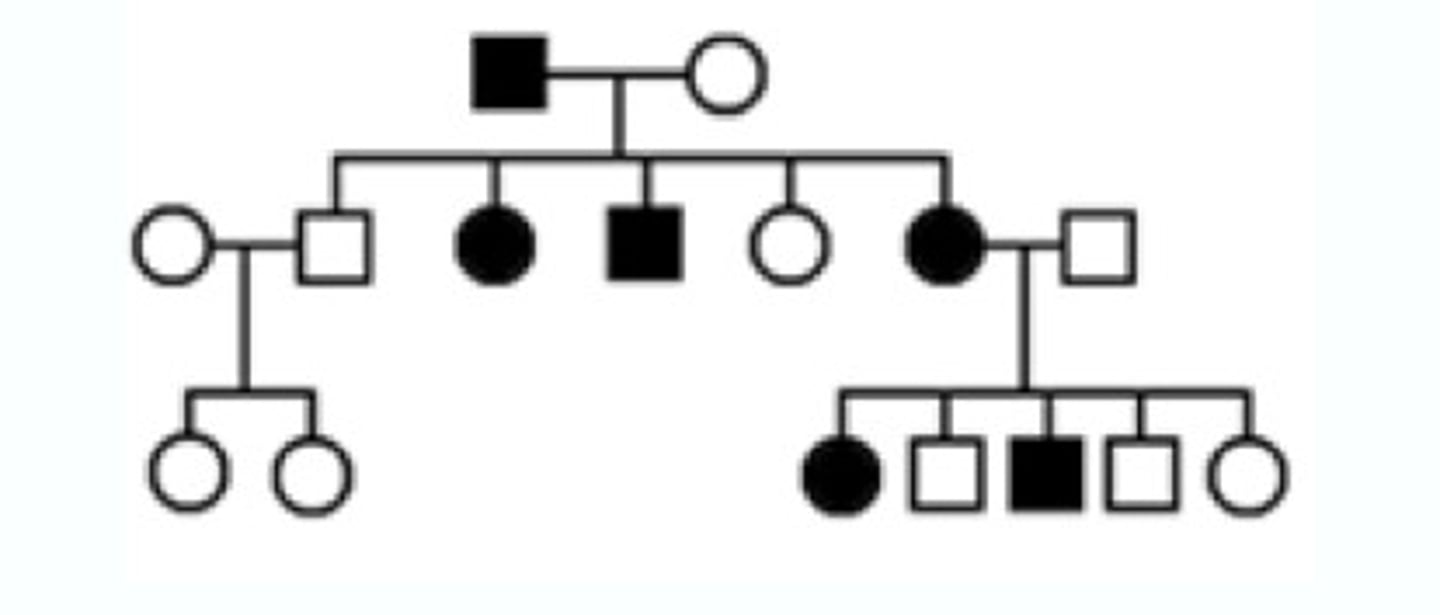
kin recognition and altruism
- spatial association
- social association
- phenotype matching
spatial association
treat those around you as kin
social association
treat those from childhood as kin
phenotype matching
treat those who resemble you as kin
cooperation in the animal world
- is rare
- cooperation among non-kin is almost nonexistent
- ex: vampire bats and blood; "full" bat will sometimes regurgitate blood into a hungry bat's mouth if the bat has helped it out before
- ex: bicycle sharing programs have failed numerous times in cities
26. Unexpected cooperation and conflict: when and why do we seem them?
WE DONT
- sterile worker honeybees: they're closely relates
- non-reproductive worker naked mole rats for the queen: since they're isolated int their burrows, the small population has been inbred so they share alot of the same alleles, so all individuals in a population have extremely high coefficients of relatedness
- mother and her fetus; fetus pumps out hormone hPL that dilates mother's blood vessels while mother increases insulin production --> possibly gestational diabetes if mother can't mount a sufficient insulin response
- truces in WWI troops among those facing each other across trenches for a long time
27. Reciprocal altruism: under what conditions should we see it
- repeated interactions
- high benefit to the recipient relative to the cost of the actor
- keep tabs on people and punish cheaters
R.B.T. - Rowdy Bitches Talk